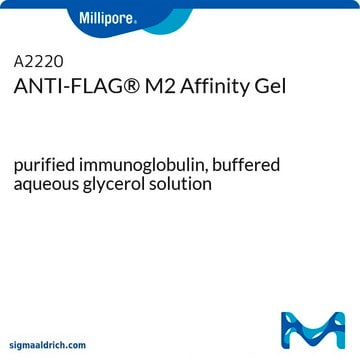M8823
Anti-FLAG® M2 Magnetic Beads
affinity isolated antibody
동의어(들):
Monoclonal ANTI-FLAG® M2 antibody produced in mouse, FLAG® magnetic affinity resin, FLAG® resin for high throughput, Flag® Affinity resin, Anti-ddddk, Anti-dykddddk
About This Item
추천 제품
결합
magnetic beads
Quality Level
항체 형태
affinity isolated antibody
항체 생산 유형
primary antibodies
클론
M2, monoclonal
양식
suspension
유통기한
2 yr at -20 °C
분석물 화학적 분류
proteins
기술
affinity chromatography: suitable
immunoprecipitation (IP): suitable
비드(bead) 크기
20-75 μm
Matrix
superparamagnetic iron impregnated 4% agarose bead, with an average diameter of 50 μm.
동형
IgG1
용량
≥0.6 mg/mL binding capacity
배송 상태
wet ice
저장 온도
−20°C
유사한 제품을 찾으십니까? 방문 제품 비교 안내
일반 설명
애플리케이션
Elution - FLAG® peptide, Glycine, pH 3.5, 3x FLAG® peptide
Learn more product details in our FLAG® application portal.
특징 및 장점
- Very rapid separation
- Significantly accelerated manipulations, such as repetitive washings
- Processing of multiple samples performed in plate formats
This leads to:
- Faster experimentation
- Better reproducibility
- More accurate quantitation of the proteins of interest
물리적 형태
법적 정보
면책조항
적합한 제품을 찾을 수 없으신가요?
당사의 제품 선택기 도구.을(를) 시도해 보세요.
관련 제품
Storage Class Code
12 - Non Combustible Liquids
WGK
WGK 1
Flash Point (°F)
Not applicable
Flash Point (°C)
Not applicable
개인 보호 장비
Eyeshields, Gloves, multi-purpose combination respirator cartridge (US)
가장 최신 버전 중 하나를 선택하세요:
시험 성적서(COA)
이미 열람한 고객
문서
The FLAG® Expression System is a proven method to express, purify and detect recombinant fusion proteins. Sigma®, the proven provider of FLAG®, now offers a magnetic bead for immunoprecipitation, protein purification, and the study of protein-protein interactions. The ANTI-FLAG® M2 Magnetic Bead is composed of murine derived, anti-FLAG® M2 monoclonal antibody attached to superparamagnetic iron impregated 4% agarose beads, with an average diameter of 50 µm. The M2 antibody is capable of binding to fusion proteins containing a FLAG peptide sequence at the N-terminus, Met-N-terminus, or C-terminus locations in mammalian, bacterial, and plant extracts.
Comparison of elution techniques for small-scale protein purification of FLAG® tag proteins using anti-FLAG® M2 magnetic beads.
관련 콘텐츠
Protein purification techniques, reagents, and protocols for purifying recombinant proteins using methods including, ion-exchange, size-exclusion, and protein affinity chromatography.
이온교환, 크기 배제 및 단백질 친화성 크로마토그래피를 포함한 방법을 사용하는 재조합 단백질 정제를 위한 단백질 정제 기법, 시약 및 프로토콜.
E. coli, 곤충, 효모 및 포유류 발현 시스템에서 재조합 단백질을 발현하고 요법과 백신 생산을 지원하는 단백질 발현 기술.
Protein expression technologies for various expression systems supporting research, therapeutics, and vaccine production.
자사의 과학자팀은 생명 과학, 재료 과학, 화학 합성, 크로마토그래피, 분석 및 기타 많은 영역을 포함한 모든 과학 분야에 경험이 있습니다..
고객지원팀으로 연락바랍니다.











